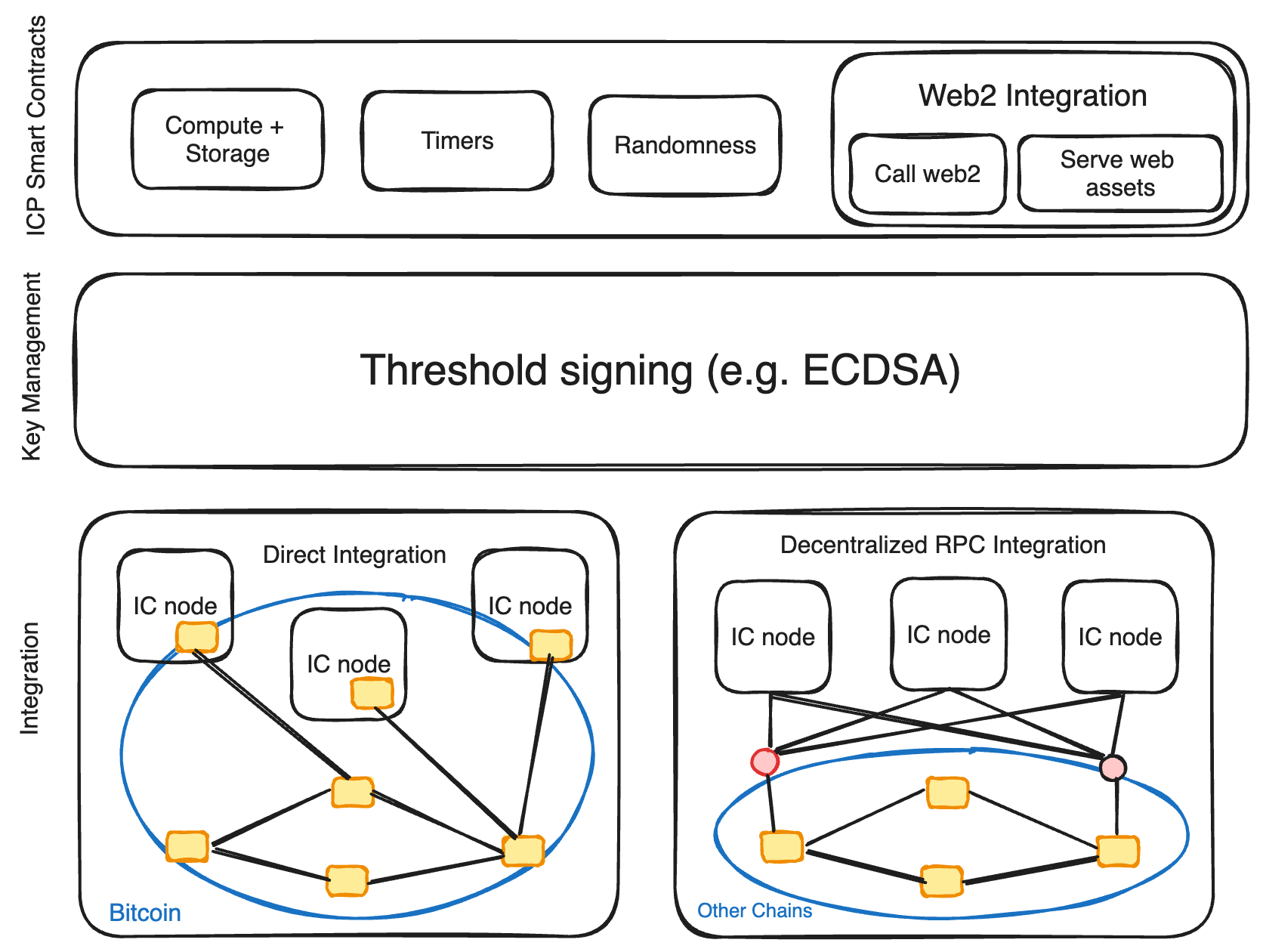Overview
The chain fusion capabilities of the BigFile allow multiple blockchains to interconnect in a decentralized manner, eliminating the need for a single trusted intermediary. The key building blocks enabling this integration are (1) a decentralized bi-directional communication of the BigFile with other chains and (2) the ability of BIG smart contracts to sign and submit transactions to other chains.
Chain fusion augments smart contracts and decentralized applications (dapps) on non-BIG chains with the unique capabilities of BIG, including:
Web2-like user experience: Due to low cost, fast finality, and the reverse gas model, interacting with a smart contract on BIG closely resembles the user experience of traditional web services. By complementing non-BIG smart contracts with user interfaces served from BIG, the user can interact with these smart contracts using a standard browser, without installing a crypto wallet or relying on a single point of trust.
Performance: Smart contracts on the BIG possess the power to support a vast range of web services, from social networks to full-fledged AI models. Thus, chain fusion allows to build more powerful dapps combining non-BIG smart contracts with the decentralized compute power of BIG.
Storage: Using a competitive pricing model, a single smart contract on BIG offers up to 400GiB of storage, enabling all application data to be stored on-chain. Through chain fusion, these decentralized storage capacities are made available to non-BIG dapps.
Autonomy: Unlike traditional blockchains, smart contracts on BIG are capable of scheduling messages for themselves at any given interval. This functionality allows smart contracts to operate without the need for user inputs or arbitrage to maintain their services. Chain fusion provides this autonomy to non-BIG smart contracts without sacrificing decentralization.
Interoperability with Web2: BIG’s HTTP outcall feature permits canisters to reach out to any web service in a replicated fashion, using deterministic response results. Chain fusion brings this Web2-Web3 interoperability to non-BIG dapps.
The following examples illustrate the variety of use cases enabled by chain fusion:
Trustless cronjob service: Many Ethereum smart contracts depend on periodic activation of certain functions (such as loan liquidations, batching, etc.). These activations usually occur via arbitrageurs or external centralized services like Gelato.
A decentralized borrowing protocol: A DeFi protocol issuing a stablecoin backed by the world-class asset Bitcoin as collateral.
Multi-chain asset DEX: A decentralized exchange providing a uniform user experience, facilitating effortless and efficient trading of assets from different blockchains.
In-browser multi-chain wallet: Similar to a DEX, a single browser-based wallet that manages assets from different and unrelated blockchains.
On-chain frontend: Hosting an immutable or DAO-managed frontend for a smart contract on another blockchain.
Decentralized oracle: Linking Web2 services and smart contracts on other blockchains via HTTP outcalls.
How does it work and why is it secure?

BIG smart contracts
Smart contracts on BIG are called canisters. In addition to unparalleled compute and storage capabilities (see above), canisters can make use of protocol primitives that are not natively available on other chains. For example:
Canisters can request randomness from the protocol, which is useful in applications where fairness or unpredictability is required.
Timers let canisters manage their tasks by initiating specific actions periodically without depending on any external actors.
Full Web 2 integration allows canisters to both expose HTTP interfaces and call HTTP APIs hosted on the web.
Key management and signing
A key feature of the BIG protocol’s chain fusion capabilities is threshold signing. This feature allows canisters to have a pair of public and private keys. The private key is divided into small shares and distributed among nodes of a signing subnet.
Threshold signing is also referred to as chain-key cryptography.
Integrations
A canister’s interaction with external blockchains requires submitting transactions and reading the state of the other chain. BIG offers two types of such integrations:
Direct integration: In case of the Bitcoin integration, BIG nodes utilize a special component called the Bitcoin adapter to connect to the Bitcoin p2p network securely and independently. A set of BIG nodes effectively constitutes a native Bitcoin node.
Decentralized RPC integration: When it comes to Ethereum integration, BIG utilizes HTTP outcalls to contact three separate JSON RPC providers (such as Ankr, BlockPI, Alchemy, and others) to retrieve the chain state and submit signed transactions.
Whom do users trust?
A key question we must answer to fully understand the security of BIG's chain fusion capabilities is: whom do users place trust in when using the presented infrastructure?
BIG’s decentralization is rooted in the replicated execution and state of canister smart contracts which depends on the honesty of a supermajority of subnet nodes. These nodes are sourced from various identifiable and DAO-approved providers that operate in globally distributed data centers.
In case of direct chain integration, the only trust assumption needed is that a supermajority of subnet nodes are honest and in consensus. In case of integration via RPC, users additionally need to trust RPC node providers. While this is seen as less secure than a direct integration that involves running a full node, it's currently deemed an acceptable trade-off (due to a reliance on replicated results from multiple independent providers).
How to build applications using chain fusion?
There are several building blocks available to augment non-BIG smart contracts with BIG’s chain fusion capabilities or to leverage chain fusion in existing BIG dapps:
Chain-key tokens: Using the primitives described above, BigFile has built two canisters implementing the BIGRC-1 token standard to represent native Bitcoin and Ethereum tokens on BIG: ckBTC and ckETH. These tokens are digital twins of their corresponding native token and are backed 1:1 by the native assets which are managed 100% on-chain through a canister smart contract without any intermediaries.
EVM RPC canister: A canister smart contract providing an on-chain API for communicating with Ethereum or any other EVM blockchain.
tECDSA signing: An BIG service implementing the threshold ECDSA protocol by Groth and Shoup as described in their Eurocrypt 2022 paper.
HTTP outcalls: Replicated calls into external web services.
Bitcoin API: A protocol API that allows canisters to interact with the Bitcoin blockchain directly.